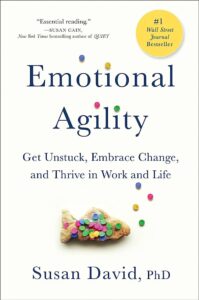EMOTIONAL AGILITY by Susan David, Ph.D.
 “WANT-TO goals reflect a person’s genuine interest and values (they’re “WHY”).
“WANT-TO goals reflect a person’s genuine interest and values (they’re “WHY”).
We pursue these kinds of goals because of personal enjoyment (intrinsec interest),
because of the inherent importance of the goal (identified interest),
or because the goal has been assimilated into our core identity (integrated interest).
But most important, these goals are freely chosen by us.”
“HAVE-TO goals, on the other hand, are imposed, often by a nagging friend or relative (“you’ve gotta lose that gut”) or by our own sense of obligation to some internal narrative or external goal, typically related to avoiding shame (“Good grief! I look like the Goodyear blimp”).”
“Studies show, for instance, that two people with the same goal of losing five pounds will see the same serving of chocolate mousse very differently depending on their motivation:
The person with a WANT-TO motivation will physically experience it as less tempting (“The dessert looks nice, but I’m just not that interested”) and will perceive fewer obstacles in the process of sticking to the goal (“There are lots of other, healthier options on the menu”).
WANT-TO motivation is associated with lower automatic attraction toward the stimuli that are going to trip you up and instead draws you toward behaviours that can actually help you achieve your goals.”
“HAVE-TO motivation, on the other hand, actually ramps up temptation because it makes you feel constricted or deprived.
In this way, pursuing a goal for HAVE-TO reasons can actually undermine your self-control and make you more vulnerable to doing what you supposedly don’t want to do.”
Kindle, 2022



Recent Comments